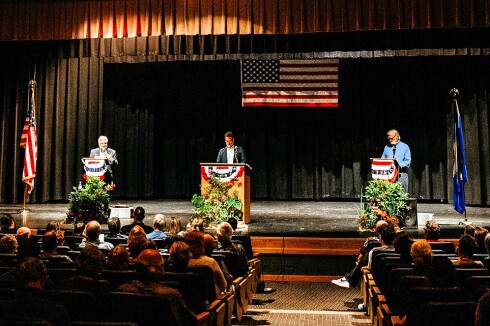In the first few decades of the 20th century, Duluth was a hotbed of labor battles, corporate spying and, gasp, even communism.
In fact, the Northland plays the central role in Frank Palmer's 1928 "Spies in Steel," a shocking account of the United States Steel Corporation's far-reaching spy system. In it, Palmer details how spies (identified only by number, like No. 9) who were members of various unions in the Iron Range and Duluth would attend meetings, then send in notes and names of new members to post office boxes in Duluth.
ADVERTISEMENT
From the post office, the reports would travel to the "headquarters" of this spy network, which were located in the offices of the Oliver Mining Company on the upper floors of the Lyceum Building in downtown Duluth.
It was not a harmless activity, because any worker talking about unions would likely be fired and find himself on a blacklist used by anti-union employers, according to "We Accept the Challenge" authors Erik Peterson and Richard Hudelson. In this brief bullet-point guide, the pair basically do a walking/driving tour of Duluth's labor history, from the Labor Temple at 2002 London Road -- where Labor World, Minnesota's oldest continuously published labor newspaper (founded by a single mother in 1896), is located -- to the site in Proctor where more than 500 men (and some women) went on strike in 1922. That strike was broken after the company imported scabs and hired gunmen, but the spirit lived on.
Still, it would be wrong to imply that Communists formed a majority party in the Northland then. The fact is, labor issues were at the forefront in the Twin Ports and beyond. Workers at the ore docks, the coal docks, the steel mill and the mining companies wanted decent pay and decent working conditions. Working against them was the Citizen's Alliance, a "virulently" anti-labor organization, as well as the Commercial Club, predecessor to the Chamber of Commerce.
However, Duluth had some heavy hitters in the Communist Party to rally the struggling masses.
Political Science 101
~ Peterson's copy in italics from this point on.
First things first: What is the difference between socialism and communism?
ADVERTISEMENT
Before 1919, there basically was no difference.
"When Marx wrote his manifesto of the Communist Party, he uses the term socialism in the same text," explained Richard Hudelson, author and University of Wisconsin-Superior professor. "Socialism was a 'big-tent' term that included Marxists, Christians, anarchists."
Then came the Russian Revolution.
"There was a definite split in the International Socialist movement in 1919, fundamentally over the Russian Revolution (which took place in two different uprisings in 1917 and was followed by a four-year civil war) and what to make of the Revolution," Hudelson said. "One side saw it as a betrayal of Marxism -- the side that saw it as undemocratic was probably the largest part -- and the other side supported the revolution and followed [Vladimir] Lenin's idea of the need for strong leadership and discipline. That [Lenin's way] is what became known as the Communist movement.
It was really not a difference in ideals, he went on to explain, noting that both socialism and communism are philosophically opposed to capitalism (although not democracy).
"It's not so much about the vision of the type of world they want to create," he said. "It's really a fight over how we're going to get there."
Communists in the Twin Ports
ADVERTISEMENT
~ Hudelson
When the International Socialist movement split into two camps in 1919, the largest part of the Socialist Party of Duluth joined the newly formed Communist International. Duluth's 400 Scandinavian Socialists, comprising at that time the largest Scandinavian Socialist local in the United States, went first, becoming a founding local of the Communist Labor Party in late fall of 1919. The even larger Finnish Socialist locals in Superior and Duluth helped lead the Finnish Socialist Federation of North America into the Communist movement in late 1921.
Rebuffed in an attempt to gain control over the emerging Farmer-Labor Party in 1924, Communists in Minnesota and the Twin Ports remained on the political sidelines throughout the 1920s and early 1930s. However, local Finnish Communists did play a significant leadership role in the Finnish Cooperative Movement, based in Superior.
With a base in the cooperative stores and Finn Halls scattered across the region, and with a powerful voice in Ty'mies (the Finnish language newspaper published in Superior), local Communists played a significant role in the development of the Communist Party in the United States.
Word from Moscow causes split
In 1929, a directive from Moscow demanded that local Communists assert greater control over the Finnish cooperative movement. This split the Finnish Communists in the Twin Ports area, with some abandoning the Communist Party to defend democratic control over the co-ops and others remaining loyal to the Communist Party.
The split was a traumatic event for left-wing Finns in the Twin Ports. Some of those who remained loyal Communists left the Twin Ports, taking their families to Soviet Karelia where they hoped to help build a socialist future in the Soviet Union.
ADVERTISEMENT
This "Red Exodus," (to borrow the title from one of the books written by Mayme Sevander who emigrated to Karelia with her family) weakened the Communists locally and had tragic results for the families involved.
Sevander's book, "They Took My Father," provides a wonderful account of both the idealism that motivated this exodus and its tragic outcome.
Not the expected utopia
What happened when those loyal Twin Ports communists arrived in Karelia with their families in tow?
"Many of the men were murdered, because they were seen as potential challenges to Stalin," Hudelson said, adding that writer Mayme Sevander's father was arrested, taken into the woods and shot. "After
that came the war, so these families then faced war, famine and poverty."
A party revived
ADVERTISEMENT
In the 1930s, with global capitalism in chaos and massive unemployment gripping the Twin Ports, remnants of the Scandinavian Communist local, which had gone largely dormant after 1923, along with a group of young Jewish activists, joined and re-invigorated the Communist movement in the Twin Ports. They began agitating on behalf of the unemployed, organized unions among the mass of unorganized immigrant laborers in the Twin Ports, and began to play leadership roles within the Farmer-Labor Party in Duluth, the Iron Range and the state of Minnesota generally.
Heavy hitters
Communists played a significant role in Duluth in the late 1930s and early '40s.
Joe Van Nordstrand -- an organizer for the Steel Workers Organizing Committee in Duluth, a representative of steel plant Local 1028 to the CIO Industrial Union Council in Duluth, and an elected vice chair of the Minnesota CIO -- was a key player locally. Van Nordstrand had been, under the name of Joe Moreland, an organizer for District Nine of the Communist Party serving Duluth and the surrounding region.
Midwest Labor, the CIO newspaper published in Duluth, was edited by Sam Davis, a Duluth man who had run for office as the Communist Party candidate for governor of Minnesota in 1934. Irene Paull, another local Communist and gifted fiction writer, wrote for Midwest Labor. Ilmar Koivunen, another area Communist, served on the editorial board for the newspaper and led the local Timber Workers union.
"I think we had an interesting group of heavy hitters locally," Hudelson said, noting that the idea of a few very strong players goes back to the Lenin's idea of communism. "One of Lenin's key ideas was that you needed a group of leaders who would work really hard and in a disciplined way to bring about change, people willing to dedicate their lives to this. ... There were relatively few Communist activists here, but we had some very able people locally."
As for Communist activist Joe Moreland (aka Joe Van Nordstrand), Hudelson said that being a known Communist came with health hazards, which explains the name change.
ADVERTISEMENT
"At one point, very early on, the party was an illegal organization," he said. "By 1921-22, it had established a legal presence. But Communist organizers might get beat up, or shot even.
"It was kind of a risky business."
Not a long-lived party
Anti-Communists within the Farmer-Labor Party and the trade unions fought back against Communist influence. Anne McEwen was forced out from her position as editor of Labor World, charged with being a "Red."
Buster Slaughter of the Longshoremen and Glenn Peterson from Local 1028 were among local labor leaders who fought hard to drive the Communists out of the local labor movement. And, in 1948, with help from Hubert Humphrey, local anti-Communists were successful in taking control of the now merged Democratic-Farmer-Labor Party away from the influence of local Communists.
Isolated from the unions and the DFL and increasingly harassed by the FBI during the McCarthy era, Communists ceased to play a significant organizational role in the Twin Ports by the early 1950s.
Richard Hudelson is the author of five books, including "By the Ore Docks: A Working People's History of Duluth" and a Professor of Philosophy at the University of Wisconsin Superior. "By the Ore Docks" is available at all the major bookstores and online. E-mail questions and comments to jpeterson@duluthbudgeteer.com .









